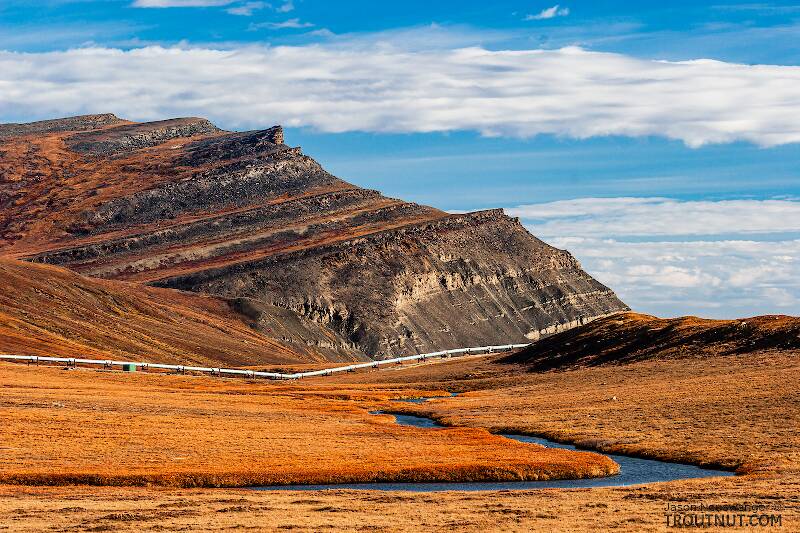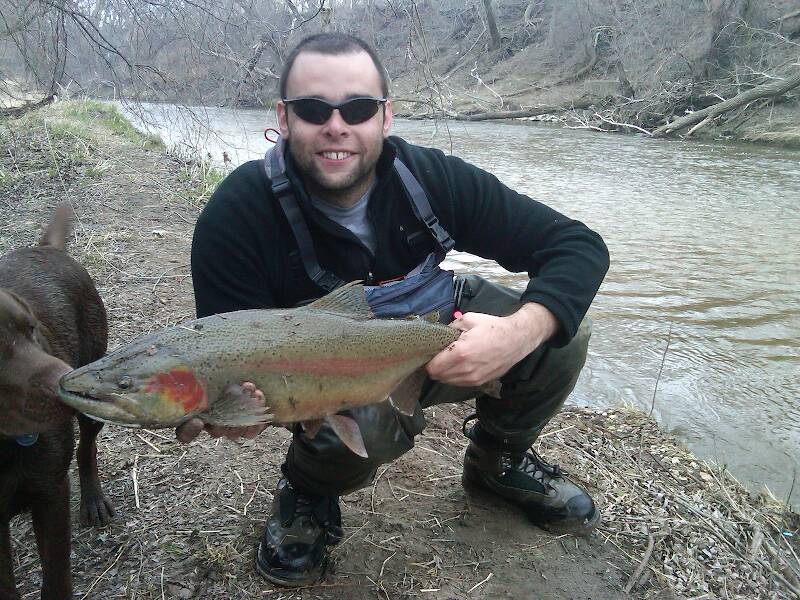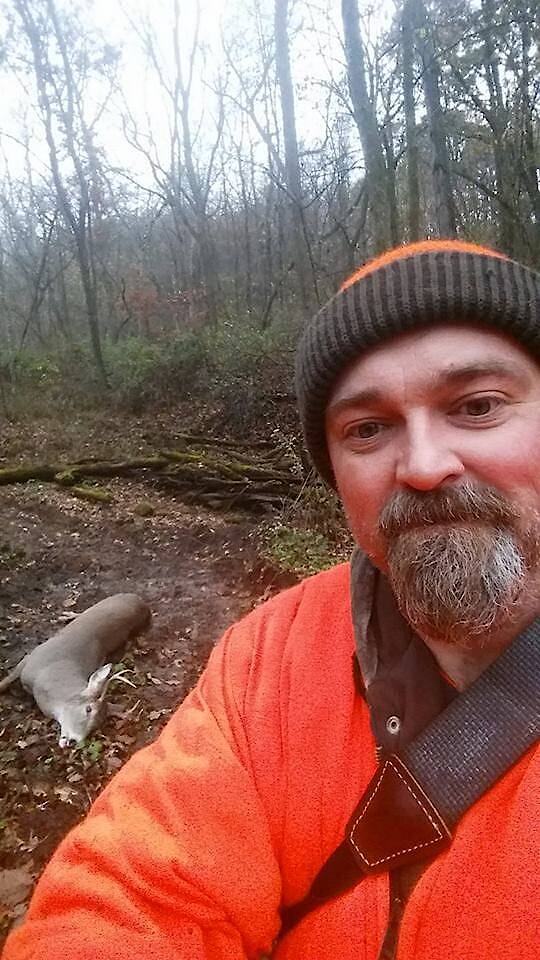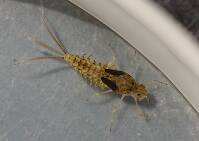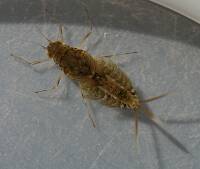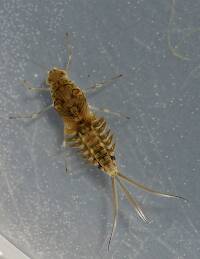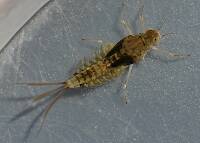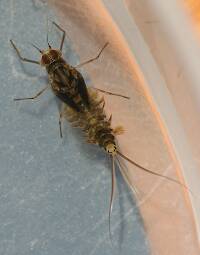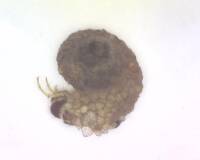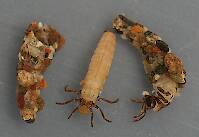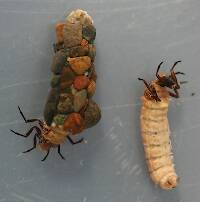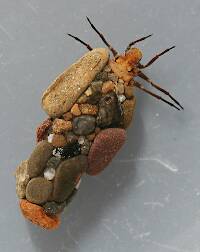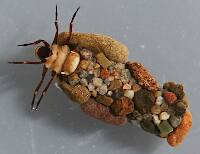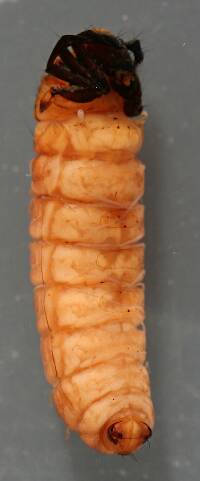
Salmonflies
Pteronarcys californica
The giant Salmonflies of the Western mountains are legendary for their proclivity to elicit consistent dry-fly action and ferocious strikes.
Featured on the forum

Troutnut is a project started in 2003 by salmonid ecologist Jason "Troutnut" Neuswanger to help anglers and
fly tyers unabashedly embrace the entomological side of the sport. Learn more about Troutnut or
support the project for an enhanced experience here.
Kschaefer3 on Sep 12, 2012September 12th, 2012, 4:59 am EDT
I have been fishing Minnesota's SE trout streams for about 7 years. I can generally go catch a pile of small (8"-12") fish, but nothing bigger. This year I started to pursue bigger fish. I have failed miserably, with the exception of my trip to bigger water. 14" is my biggest out of MN.
I know that there are a lot of people who fish Driftless WI with great success for larger fish. I know there are some 20"+ fish in MN as well, I just haven't found them, and they seem to be more rare. I took one trip to Driftless, it was mid-summer, so the fishing was slow to say the least. However, I did spot several fish that looked 16-20".
Can anyone speak to the differences between MN and WI (Driftless) trout streams? Why does one hold more large fish? Or am I just fishing wrong? This has been bothering me for quite some time, so I would appreciate any help.
I know that there are a lot of people who fish Driftless WI with great success for larger fish. I know there are some 20"+ fish in MN as well, I just haven't found them, and they seem to be more rare. I took one trip to Driftless, it was mid-summer, so the fishing was slow to say the least. However, I did spot several fish that looked 16-20".
Can anyone speak to the differences between MN and WI (Driftless) trout streams? Why does one hold more large fish? Or am I just fishing wrong? This has been bothering me for quite some time, so I would appreciate any help.
PaulRoberts on Sep 12, 2012September 12th, 2012, 7:47 am EDT
I have not fished those streams specifically except to say that the WI Driftless area contains limestone-rich groundwater sourced streams. This says a LOT: Fertility (means productivity in terms of food production), seasonal stability in temperature (means growth), stability in water levels can offer fingerlings more consistent survival. More surface water sourced streams (most streams in the US) tend to be less fertile and less stable in temperature and flow, resulting in overall less productivity.
There are likely to be some large trout in these "lesser" (more average) waters, but they cannot grow as large on insect fodder as they might in more productive and stable environments like spring creeks and tailwaters. The best way to up the odds in average waters is to target "gators" -large browns that have switched from insect fodder to fish. Since there are rarely many of these, this takes some effort. Some streams have more than others. Your fisheries people should be able to help you ID these.
You can break down the season from the fish’s perspective into four periods: -Summer feeding, migration, spawn, wintering. Each have their own habitat requirements, and the migration periods occur in between.
These large fish are probably most vulnerable during the migratory periods (fall into mid-spring) when they are most apt to be "exposed". You’ll need to start thinking about streams in terms of the entire watershed, as if it’s a lake, bc that’s the scope these big trout have. Think about seasonal habitat requirements, water levels for fish to move with, and barriers that might hold these fish for long enough to have a crack at them.
The spawn is the first impetus to move (behaviors run from late August through November). Wintering turf usually means large deep slow pools, often with wood cover. Early spring, associated with runoff/spates, is the time / water volume when these fish return to their summer home ranges. You may find a big fish almost anywhere at this time and it’s when most anglers “get lucky” and find a big one.
In spring and summer, these fish are in stretches that offer two things: lotsa large food (young trout, chubs, crayfish), the most common location on most watersheds being below “classic” trout water where the stream gets larger and warmer –down into “chub water”. Use a thermometer bc the water must still have periods in the day when the water is in the mid 60s or less, often at night and early AM. Too warm? Start working back upstream. These fish are often nocturnal, esp during the summer.
Effective presentation possibilities:
First, in general, drop the standard dry flies and nymphs and fish big meaty stuff that may look more like bass flies than typical trout stuff. This also means you may want to tackle up -leave the 3 and 4 wt at home and use a 5 or 6wt.
-The exception to tackling up is during emergences of larger flies (if sufficient in number) that can bring up a few of the bigger fish, esp the larger end of the “insect eaters” (usually 14-16” fish). Know your hatches and be there, although hitting it right is not clockwork.
-Big deer hair mouse, large wet fly, or streamer, fished down and/or across at night in large cover strewn pools in summering ranges.
-During daylight hours, “Flippin’”, a technique used by bass fisherman to target specific cover spots with a heavy jig is also very effective for large cover oriented trout –which most big browns are. Use a stout tippet and a nose-weighted wooly bugger and probe deep dark undercuts, wood, and boulder crevices.
-Hanging (or fishing across) large wets/streamers into large pools and under deep undercuts during spate periods anytime of year. Summer rain spates, or just deep overcast, can bring larger carnivores out of the woodwork during daylight hours.
-During the spawn, swing streamers along gravel-filled stretches, esp tailouts of pools. Also check undercuts and wood or boulder cover above and below these good spawning sites. Pre-spawn and post-spawn fish are most vulnerable/willing. Post-spawn fish are especially ravenous to feed and dead-drifted egg patterns work really well.
-Nymph/egg fishing eddies in deep, slow wintering pools. These wintering fish are often hungry, and good habitat can collect up more than one.
Others may have more to add to this list.
You have your work cut out for you. But pleasant work, if you can find the time to REALLY get to know your watersheds.
There are likely to be some large trout in these "lesser" (more average) waters, but they cannot grow as large on insect fodder as they might in more productive and stable environments like spring creeks and tailwaters. The best way to up the odds in average waters is to target "gators" -large browns that have switched from insect fodder to fish. Since there are rarely many of these, this takes some effort. Some streams have more than others. Your fisheries people should be able to help you ID these.
You can break down the season from the fish’s perspective into four periods: -Summer feeding, migration, spawn, wintering. Each have their own habitat requirements, and the migration periods occur in between.
These large fish are probably most vulnerable during the migratory periods (fall into mid-spring) when they are most apt to be "exposed". You’ll need to start thinking about streams in terms of the entire watershed, as if it’s a lake, bc that’s the scope these big trout have. Think about seasonal habitat requirements, water levels for fish to move with, and barriers that might hold these fish for long enough to have a crack at them.
The spawn is the first impetus to move (behaviors run from late August through November). Wintering turf usually means large deep slow pools, often with wood cover. Early spring, associated with runoff/spates, is the time / water volume when these fish return to their summer home ranges. You may find a big fish almost anywhere at this time and it’s when most anglers “get lucky” and find a big one.
In spring and summer, these fish are in stretches that offer two things: lotsa large food (young trout, chubs, crayfish), the most common location on most watersheds being below “classic” trout water where the stream gets larger and warmer –down into “chub water”. Use a thermometer bc the water must still have periods in the day when the water is in the mid 60s or less, often at night and early AM. Too warm? Start working back upstream. These fish are often nocturnal, esp during the summer.
Effective presentation possibilities:
First, in general, drop the standard dry flies and nymphs and fish big meaty stuff that may look more like bass flies than typical trout stuff. This also means you may want to tackle up -leave the 3 and 4 wt at home and use a 5 or 6wt.
-The exception to tackling up is during emergences of larger flies (if sufficient in number) that can bring up a few of the bigger fish, esp the larger end of the “insect eaters” (usually 14-16” fish). Know your hatches and be there, although hitting it right is not clockwork.
-Big deer hair mouse, large wet fly, or streamer, fished down and/or across at night in large cover strewn pools in summering ranges.
-During daylight hours, “Flippin’”, a technique used by bass fisherman to target specific cover spots with a heavy jig is also very effective for large cover oriented trout –which most big browns are. Use a stout tippet and a nose-weighted wooly bugger and probe deep dark undercuts, wood, and boulder crevices.
-Hanging (or fishing across) large wets/streamers into large pools and under deep undercuts during spate periods anytime of year. Summer rain spates, or just deep overcast, can bring larger carnivores out of the woodwork during daylight hours.
-During the spawn, swing streamers along gravel-filled stretches, esp tailouts of pools. Also check undercuts and wood or boulder cover above and below these good spawning sites. Pre-spawn and post-spawn fish are most vulnerable/willing. Post-spawn fish are especially ravenous to feed and dead-drifted egg patterns work really well.
-Nymph/egg fishing eddies in deep, slow wintering pools. These wintering fish are often hungry, and good habitat can collect up more than one.
Others may have more to add to this list.
You have your work cut out for you. But pleasant work, if you can find the time to REALLY get to know your watersheds.
Kschaefer3 on Sep 12, 2012September 12th, 2012, 9:27 am EDT
Thanks for all the advice, Paul! Thinking about these fish in a more seasonal manner makes a lot of sense. I ditched the bugs quite a while ago for swinging or stripping larger streamers. I have also gone mousing several times. By the sounds of some of the crashes, I've had big fish hit, I just miss them. I have been reading on mousing tactics. If I can get my patience down and remember to strip set I should have a shot at some nice ones at night.
I never even thought about "pitching" flies like I'm bass fishing. That is a tactic I will use for sure. I need to start working on my bow and arrow cast...I can think of several spots already :)
I will definitely employ the tactics you gave, but the reason I ask the question is that MN and WI streams are both limestone spring creeks (for the most part, and in the areas I'm referring). That is why I can't figure out why WI would be so much more productive. In general, do some of the guidelines about fish movement apply to spring creeks as well?
I never even thought about "pitching" flies like I'm bass fishing. That is a tactic I will use for sure. I need to start working on my bow and arrow cast...I can think of several spots already :)
I will definitely employ the tactics you gave, but the reason I ask the question is that MN and WI streams are both limestone spring creeks (for the most part, and in the areas I'm referring). That is why I can't figure out why WI would be so much more productive. In general, do some of the guidelines about fish movement apply to spring creeks as well?
PaulRoberts on Sep 12, 2012September 12th, 2012, 10:41 am EDT
Happy to help. Let us know what you find out. Vicarious fishing is good too.
In slow water you have to wait for the fish to handle the fly. Count to ... 2, or at night, wait until you feel some weight.
My "flippin'" involves a lot of roll casting, but also accurate aerial casting, often with a "tuck" to get the fly down quickly since you are already on the spot. You can roll and tuck too -a sharp lift of the rod tip to drive the fly downward. A vertical drop along quiet shoreline undercuts (never fished bc there is no current to support a drift) can bring dark snaky surprises out in a flash. Look for cover and depth, but sometimes only 18" water will suffice. I've seen 18" browns under little washed out root-cuts full of chubs and shiners. Like a lion lying with gazelle, the prey is only concerned when the monster goes on the hunt.
Again, I don't know about the specific streams you talk about, esp in MN. Talk to your fisheries people. They will know. I did some fisheries work in the past, in fact I spent a summer surveying "marginal" trout streams in S NYS and I remember one particular little stream I could jump over in places (with a running start) that had a marshy stretch. There were two largish deep pools (for that stream), possibly remnants of old beaver dams, that we shocked a 16, a 17 and a 19"er from. I bet NO one knew these fish even existed. And they died of old age I'd bet. Someone with some get up and go, and a woolly bugger, could have found them though.
In general, the more stable the environment, the less fish have to move. Studies on spring creeks have shown individual trout using the exact same lies year in and year out. The less stable, the more fish HAVE to move. (Often there is a strong negative correlation between land use--strip malls and housing developments--and stream stability.) But feeding, spawning, and wintering require different things of trout so the important habitat components of each must be present. Fish will travel to them, if they survive to find out. In many waters, those that "found out" may be few and far between. Each water is different and it just takes ground-truthing. An electro-shocking rig expedites things, so talk to your biologist.
In slow water you have to wait for the fish to handle the fly. Count to ... 2, or at night, wait until you feel some weight.
My "flippin'" involves a lot of roll casting, but also accurate aerial casting, often with a "tuck" to get the fly down quickly since you are already on the spot. You can roll and tuck too -a sharp lift of the rod tip to drive the fly downward. A vertical drop along quiet shoreline undercuts (never fished bc there is no current to support a drift) can bring dark snaky surprises out in a flash. Look for cover and depth, but sometimes only 18" water will suffice. I've seen 18" browns under little washed out root-cuts full of chubs and shiners. Like a lion lying with gazelle, the prey is only concerned when the monster goes on the hunt.
Again, I don't know about the specific streams you talk about, esp in MN. Talk to your fisheries people. They will know. I did some fisheries work in the past, in fact I spent a summer surveying "marginal" trout streams in S NYS and I remember one particular little stream I could jump over in places (with a running start) that had a marshy stretch. There were two largish deep pools (for that stream), possibly remnants of old beaver dams, that we shocked a 16, a 17 and a 19"er from. I bet NO one knew these fish even existed. And they died of old age I'd bet. Someone with some get up and go, and a woolly bugger, could have found them though.
In general, the more stable the environment, the less fish have to move. Studies on spring creeks have shown individual trout using the exact same lies year in and year out. The less stable, the more fish HAVE to move. (Often there is a strong negative correlation between land use--strip malls and housing developments--and stream stability.) But feeding, spawning, and wintering require different things of trout so the important habitat components of each must be present. Fish will travel to them, if they survive to find out. In many waters, those that "found out" may be few and far between. Each water is different and it just takes ground-truthing. An electro-shocking rig expedites things, so talk to your biologist.
Minnesota on Oct 15, 2012October 15th, 2012, 11:44 pm EDT
I've been fishing around Caledonia MN for almost 40 years. I've found that the larger fish are eating chubs and minnows. Find the deep holes and fish off the bottom with a large sculpin fly or leech pattern even. I've caught alot of large trout on Rapalas. Sometimes as soon as it hits the water, they rise up and nail it. I usually put the fish back, but I was doing taxidermy at the time, and I kept a 21 incher to mount. The stomach had 2 chubs about 5 inches long in its belly. I moved 20 miles away across the mississippi river to LaCrosse where I live now. The streams east of here are a little different. Some should be classified more as rivers. We have alot of flooding. We have had 2 huge floods. And now this year we have had a drought. The streams are in real rough shape. I guess in closure to my rambling, Big Fish=Big Bait. Oh yeah, NE Iowa has some nice big streams too.
Jason Moe
Bkd53028
Posts: 1
Posts: 1
Bkd53028 on Mar 8, 2016March 8th, 2016, 7:32 am EST
I started fishing the SE MN Driftless last year after a few years fishing NE IA Driftless. I much prefer SE MN. The big fish are there, and in spades, at least in recent years. Look under bridges (Dushee Creek or Blagsvedt Creek, for example) or the cribbing that the fisheries department has established in many creeks. Also, I've caught several 18+ rainbows in front of the dam at Lanesboro off of simple zebra midge patterns in the summer. I will agree, however, that the bread and butter fish are in the 10 - 12 inch range and mainly consist of wild browns. These are lots of fun to catch on dry flies on the South Branch of the Root River just outside of Preston, MN, or in Camp Creek east of Preston. By far the biggest fish I have seen in SE MN were at Trout Run Creek, but they were nearly impossible to catch. I was nymphing large patterns right on their noses only for them to sniff and turn away. The water is so clear that you can see down 3-4 feet and watch the big guys hold next to rocks. Perfect fishing conditions, but I couldn't get these guys to take anything. So strange.
To really witness big fish in SE MN, go to Bucksnort and sit on the park bench for about ten minutes. You will see some very, very large fish attempt to jump the dam after a while. You can cast to these fish, but they are also very picky.
I have never fished WI Driftless but I've often wondered which is "better". I'll get my chance this summer when I fish Caves Creek and some streams surrounding Viroqua. I'll make sure to leave a detailed report here.
To really witness big fish in SE MN, go to Bucksnort and sit on the park bench for about ten minutes. You will see some very, very large fish attempt to jump the dam after a while. You can cast to these fish, but they are also very picky.
I have never fished WI Driftless but I've often wondered which is "better". I'll get my chance this summer when I fish Caves Creek and some streams surrounding Viroqua. I'll make sure to leave a detailed report here.
Kschaefer3 on Mar 8, 2016March 8th, 2016, 8:53 am EST
Wow, really digging back into the archives on this one! I have since figured out that there are indeed large trout in both MN and WI, and have managed to catch a few too. I probably just needed to learn how to fish. 14-16" fish no longer seem big, and I catch quite a few fish over 18" any given season. I still don't crush it on fish over 20", but I've found a few, and know where plenty more live. Now to find more time to stalk them!
Quick Reply
Related Discussions
Topic
Replies
Last Reply
1
Mar 29, 2009
by Taxon
by Taxon
4
Oct 10, 2018
by Jmd123
by Jmd123

